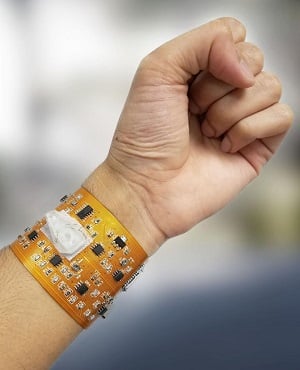A convergence of technologies continues to drive advances in medical device design as biomedical engineers exploit 3D printing, robotics and other disciplines to benefit diagnostics, health monitoring and disease treatment. Here is a sampling of notable medical equipment innovations posted during the last decade.
A kinder, gentler approach to diabetes monitoring
Finger sticks to gauge glucose levels are becoming a painful practice of the past. Diabetics are being presented with more ways to discard needles in favor of body-worn sensors and patches that perform this task noninvasively.
An adhesive patch under development at the University of Bath, U.K., draws glucose from interstitial cells and  The Dexcom G6 Continuous Glucose Monitoring System measures glucose levels just beneath Quincy’s skin. Source: San Diego Zoomeasures the concentrations with miniature sensors. Another wearable device, a hydrogel-based contact lens designed at Purdue University, does more than improve vision: embedded ultrathin conformal sensor circuits form a smart lens platform for continuous detection of glucose, lactate and pH.
The Dexcom G6 Continuous Glucose Monitoring System measures glucose levels just beneath Quincy’s skin. Source: San Diego Zoomeasures the concentrations with miniature sensors. Another wearable device, a hydrogel-based contact lens designed at Purdue University, does more than improve vision: embedded ultrathin conformal sensor circuits form a smart lens platform for continuous detection of glucose, lactate and pH.
For the pediatric set, researchers developed a pacifier-based biosensor that tracks real-time glucose levels in saliva and wirelessly transmits data to a cellphone app. The biosensor can be used to diagnose and treat diabetes from an early age.
The marsupial set is also benefiting from noninvasive glucose level tracking technology. Caretakers of a diabetic koala at the San Diego Zoo are using the Dexcom G6 Continuous Glucose Monitoring System to measures glucose levels just beneath Quincy’s skin and send data wirelessly to a display device through a transmitter.
Robotics
It is a technology that offers increased surgical precision and repeatability, targeted drug delivery, faster diagnostics and even hospital housekeeping tasks. The field of robotics is continually expanding to cover a variety of roles in the medical environment.
The Flex Robotic System from Massachusetts startup Medrobotics can be guided by surgeons through complex twists and turns to reach hard-to-access body targets. The system combines the benefits of a rigid laparoscope with a flexible endoscope in a disposable Flex Drive, which snaps into a reusable base that contains system motors and controls.
Germ-zapping robots are roaming hospital corridors to reduce the incidence of hospital-acquired infections. The cleaning routines of these ambulatory automatons include delivery of high-intensity UV light and pulsed xenon UV light to disinfect surfaces.
Medically useful automatons have also been developed at minute scales. A magnetically steerable robot engineered at MIT is capable of navigating through narrow, winding environments like the brain. The hydrogel-coated robotic thread might be paired with common endovascular protocols and enable surgeons to examine brain vessels and treat blockages or lesions.
3D printing
Emerging med tech applications for additive manufacturing include printing soft tissue-like structures, prosthetics and even replacement organs.
Customized 3D-printed middle ear prosthetics can improve the accuracy of surgical intervention in patients with conductive hearing loss. Researchers have also applied this manufacturing approach to the design of transcatheter aortic valves, which must be perfectly sized to prevent leaks or dislodgment once inserted. BioMimics from Stratasys provides the capability to 3D print realistic, functionally accurate medical models of complex anatomical structures for use in medical training, education and advanced device testing.
The ability to 3D print cardiac structures has been extended to the fabrication of a heart containing blood vessels, cells and chambers, using patients’ own biological material. Patient-specific, immune-compatible cardiac patches with blood vessels and, subsequently, an entire heart, were 3D printed with a hydrogel bio-ink/stem cell mixture. The resulting anatomically precise organ, about the size of a rabbit’s heart, is not yet ready for actual implantation, but the technology demonstrated at Tel Aviv University is expected to broaden approaches for organ replacement after failure, or for drug screening in specific anatomical structures.
Wearable devices
Wearable technology has moved beyond the now seemingly ubiquitous fitness tracker, with new systems capable of real-time monitoring of specific health conditions and data sharing with clinicians.
 A smart wristband that performs blood assays. Source: Abbas FurniturewallaA wearable patch from the University of California San Diego non-invasively monitors central blood pressure four centimeters below the surface of the skin. The device can be used to continuously monitor blood pressure in heart or lung disease patients and help doctors diagnose cardiovascular problems earlier than currently available blood pressure monitoring methods.
A smart wristband that performs blood assays. Source: Abbas FurniturewallaA wearable patch from the University of California San Diego non-invasively monitors central blood pressure four centimeters below the surface of the skin. The device can be used to continuously monitor blood pressure in heart or lung disease patients and help doctors diagnose cardiovascular problems earlier than currently available blood pressure monitoring methods.
Rutgers University-New Brunswick engineers developed a wireless smart wristband that performs blood assays. Blood samples collected through pinpricks are analyzed in an embedded microfluidic system, and results are transmitted via Bluetooth to a smartphone to enable remote health monitoring. Similarly, an accelerometer embedded in a wristband was designed by the NIH’s Women’s Healthcare Initiative to predict when a person is going to fall due to instability.
Developments in the next decade
The near-term medical technology forecast calls for wider application of virtual reality, artificial intelligence (AI) and the internet of medical things (IoMT).
Popular for gaming applications, virtual and augmented reality programs are likely to find wider use in enhancing traditional medical educational avenues. Anatomical functions and structures that are difficult to visualize through traditional means can be realistically represented through a growing number of simulation apps designed for medical studies.
An increasing number of connected medical devices that are able to generate, collect, analyze and transmit data is forming the IoMT — a connected infrastructure of medical devices, software applications and health systems and services. The deployment of digitally enabled monitoring and diagnostic systems is expected to streamline the collection and evaluation of patient health data.
AI will make a major contribution to the automated analyses of the reams of data amassed by the IoMT, fostering preventive medicine and new drug discovery. AI systems, as exemplified by IBM’s Watson, can sift through research data and medical images to quickly and accurately discover patterns that improve predictive analysis of medical conditions.

